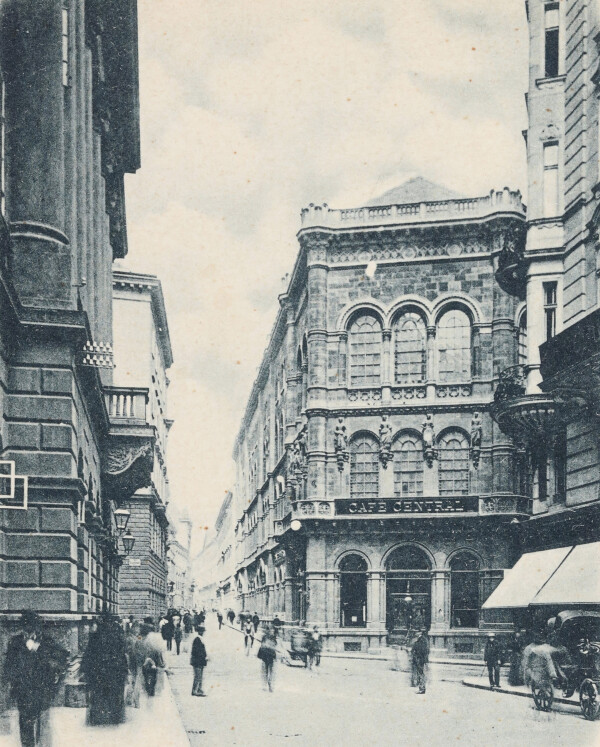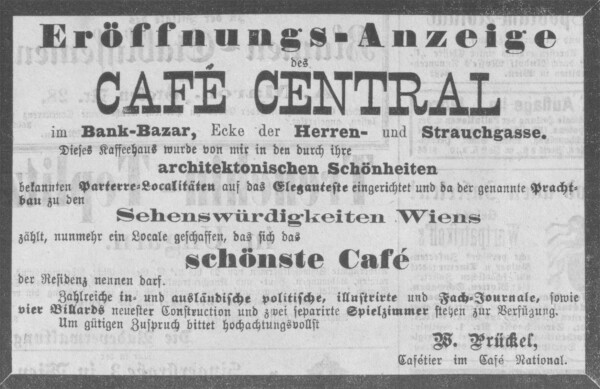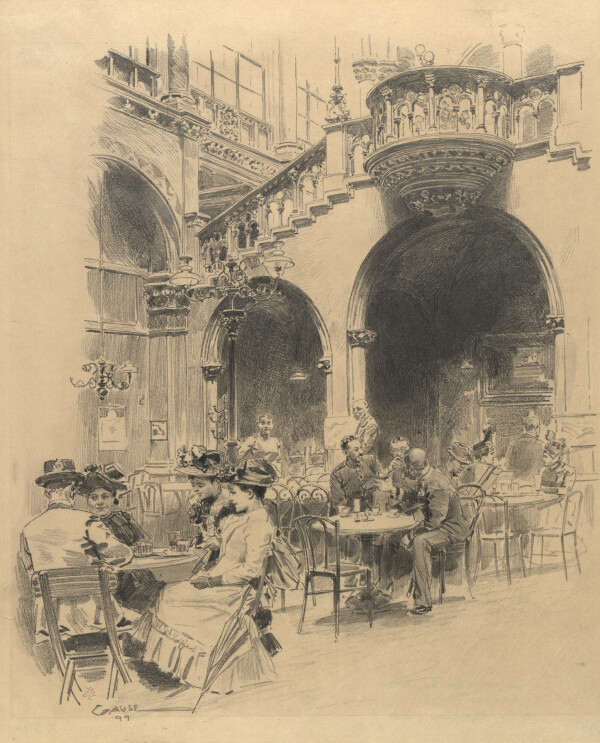Café Central

Café Central, around 1898
© Wien Museum

Opening advertisement of Café Central, in: Kikeriki. Humoristisches Volksblatt, 30.04.1876.
© ANNO | Austrian National Library

Wilhelm Gause: Arcaded courtyard in Café Central, 1899
© Wien Museum
The famous Café Central is situated in Vienna’s inner city at the corner of Herrengasse and Strauchgasse, in the so-called Ferstel Palace. At the fin de siècle, it was one of the most important meeting points of modernist artists and literati.
In 1855, the Imperial-Royal Austrian National Bank commissioned Heinrich Ferstel, the architect of the Votivkirche and the University, to design a new block of buildings between Herrengasse and Freyung. Although the building area was rather irregular, it was possible to complete the historic edifice by 1860. Apart from the bank, the building accommodated a trading floor of the stock exchange, a bazaar, and a coffeehouse.
The façades facing Herrengasse and Strauchgasse were structured in the form of squared stones, whereas the interior parts of the building featured elaborate pillars, stairways, balustrades, and stonemasonry. The walls were covered with various types of stone, wooden paneling, leather wallpaper, stucco lustro, and painted ornament. The so-called Danube Nixie Fountain was assigned a prominent place in the bazaar’s hexagonal courtyard inside the covered arcade.
The Café Central opened in 1876 underneath of what used to be the trading floor of the stock exchange – which in 1872 had moved to Schottenring. The café’s opening was announced as follows:
“This coffeehouse was installed by me in the most elegant fashion in the rooms on the first floor, which are known for their architectural beauty, and as this magnificent building now ranks among Vienna’s landmarks, I have thus created an establishment that may pride itself on being the imperial capital’s most beautiful café. It offers national and international political, illustrated, and specialized journals, as well as four billiard tables of the most modern construction and two separate gaming rooms. The honor of your presence is requested by W. Prückel, Cafétier of the Café National.”
The café came to be a favorite meeting point of literati and artists. Main attractions were the advertised newspapers and magazines in 22 languages, chessboards, and billiard tables. When the adjacent Café Griensteidl closed down in 1897, some of its regulars switched to the Café Central, including members of the Jung-Wien [“Young Vienna”] literary circle like Peter Altenberg, Hermann Bahr, Arthur Schnitzler, Richard Beer-Hofmann, Hugo von Hofmannsthal, Karl Kraus, and Egon Friedell. Among the most illustrious “Centralists” were also Adolf Loos, Oskar Kokoschka, Otto Soyka, Stefan Zweig, and Sigmund Freud. Although some of its guests permanently moved to the newly opened Café Museum in 1899, the Central continued to be one of the principal hubs of Vienna’s intelligentsia around 1900. Alfred Polgar referred to its clientele as “people of severe misanthropy” and to its atmosphere as “a view of life.”
In September 1900, the brothers Pach, having gained many years of experience as operators of the Schweizerhaus (an inn in the Prater) and the Sophiensäle (facilities accommodating an indoor swimming pool, a concert hall, and a ballroom), took over the coffeehouse. They introduced modern novelties at the Café Central, including “elegant correspondence tables furnished with all necessary equipment,” and an even larger choice of newspapers. The café kept flourishing and was also a much-frequented place in the years between the two world wars.
In 1925, the bank, which had been renamed Austro-Hungarian Bank in 1878, moved out. In World War II, the building suffered severe damage in air raids. Having been closed in 1947, it gradually deteriorated, but in 1975 was saved from demolition and renovated. The Café Central opened its doors again in the 1980s, but since then has been a tourist attraction, due to its historical significance, rather than a meeting place of literati and artists.
Literature and sources
- Wien Geschichte Wiki. Cafe Central. www.geschichtewiki.wien.gv.at/Caf%c3%a9_Central (04/09/2020).
- Wien Geschichte Wiki. Palais Ferstl. www.geschichtewiki.wien.gv.at/Ferstelpalais (04/09/2020).
- Alfred Polgar: Theorie des ›Café Central‹, in: An den Rand geschrieben, Berlin 1927.
- Kikeriki. Humoristisches Volksblatt, 30.04.1876, S. 6.
- N. N.: Gebrüder Pach im "Café Central", in: Jörgel Briefe, 15.09.1900, S. 8.
- Reingard Witzmann (Hg.): Das Wiener Kaffeehaus. Von den Anfängen bis zur Zwischenkriegszeit, Ausst.-Kat., Historical Museum of the City of Vienna (Vienna), 12.06.1980–26.10.1980, Vienna 1980.

